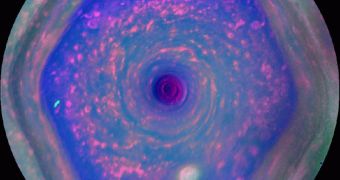Mission controllers at the NASA Jet Propulsion Laboratory (JPL), in Pasadena, California, have just released a series of impressively-accurate, high-resolution movies showing the hexagonal jet stream that envelops gas giant Saturn's north pole. This feature has fascinated astronomers for years.
The dataset was captured by the NASA Cassini spacecraft, which has been analyzing Saturn, its ring systems and its moons since achieving orbital insertion around the gas giant, on July 1, 2004. The probe has contributed an invaluable amount of data to our understanding of the gas giant.
For the new movies, the spacecraft used a variety of color filters. This is the first time a complete and accurate view of Saturn's top is collected by any space exploration mission. The dataset covers areas extending from the north pole down to about 70 degrees latitude.
Astronomers say that the hexagon is around 32,000 kilometers (20,000 miles) across, and that it features winds blowing at a speed of up to 320 kilometers (200 miles) per hour. At its core lies a massive, rotating storm that has no counterpart anywhere else in the solar system.
Since Saturn features no solid ground to speak of (except maybe deep at its core), the storm encounters no friction with landmasses or ice caps. As such, it does not slow down as it would on Earth. Both the hexagon storm and the Great White Spot on Saturn rage on for centuries.
“The hexagon is just a current of air, and weather features out there that share similarities to this are notoriously turbulent and unstable. A hurricane on Earth typically lasts a week, but this has been here for decades – and who knows – maybe centuries,” says researcher Andrew Ingersoll.
The expert holds an appointment as a Cassini imaging team member at the California Institute of Technology, in Pasadena. Caltech manages JPL for the NASA Science Mission Directorate (SMD).
Cassini used its high-resolution cameras to capture these videos of Saturn's north pole over 10 hours. This study was made possible by the fact that the Sun began illuminating the hexagon's interior in late 2012. Before that time, capturing such incredible views of the structure was impossible.
“Inside the hexagon, there are fewer large haze particles and a concentration of small haze particles, while outside the hexagon, the opposite is true. The hexagonal jet stream is acting like a barrier, which results in something like Earth's Antarctic ozone hole,” adds Cassini imaging team associate Kunio Sayanagi, from the Hampton University in Virginia.
All videos collected by Cassini are available online here.

 14 DAY TRIAL //
14 DAY TRIAL //